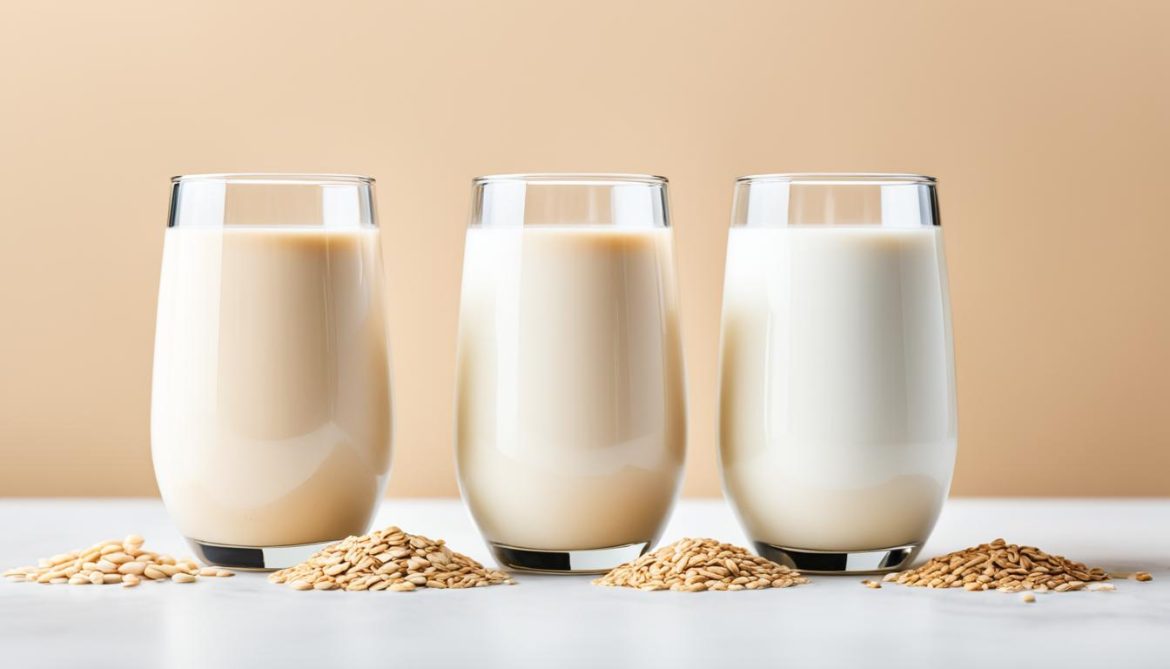Oat milk and soy milk are two popular plant-based milk alternatives that have gained significant popularity in recent years. The oat milk market was valued at around $14 billion in 2019 and is projected to continue growing. Both oat milk and soy milk offer different nutritional profiles and have distinct tastes and textures. In terms of nutrition, oat milk is lower in calories and fat compared to soy milk, while soy milk is higher in protein. Oat milk is a good option for those who are lactose intolerant or have allergies, as it is free from common allergens. Soy milk, on the other hand, is a suitable choice for those following a vegan or vegetarian diet, as it is a complete protein source. When it comes to taste, oat milk has a naturally sweet and creamy flavor, while soy milk has a nutty taste with a hint of earthiness. Both oat milk and soy milk have their own environmental impact, with oat milk being considered more sustainable due to lower water usage and carbon emissions. Overall, the choice between oat milk and soy milk depends on individual preferences, dietary needs, and environmental considerations.
Key Takeaways:
- Oat milk and soy milk are popular plant-based milk alternatives.
- Oat milk is lower in calories and fat, while soy milk is higher in protein.
- Oat milk is a good option for lactose intolerant individuals, while soy milk is suitable for vegans and vegetarians.
- Oat milk has a naturally sweet and creamy flavor, while soy milk has a nutty taste.
- Oat milk is considered more sustainable than soy milk in terms of environmental impact.
Nutritional Comparison of Oat Milk and Soy Milk
Oat milk and soy milk offer different nutritional profiles. Understanding their nutritional content can help you make an informed choice based on your dietary needs and preferences.
Calories
Oat milk contains approximately 79 calories per cup, whereas soy milk has around 100 calories per cup. If you are watching your calorie intake, oat milk may be a better option for you.
Protein
Soy milk is higher in protein compared to oat milk. A cup of soy milk provides 9 grams of protein, while oat milk contains around 4 grams. If you are looking for a milk alternative with a higher protein content, soy milk could be the way to go.
Fat
Oat milk is relatively low in fat, with approximately 1.49 grams per cup. On the other hand, soy milk contains around 5 grams of fat per cup. If you are following a low-fat diet, oat milk may be a suitable choice.
Carbohydrates
Oat milk is higher in carbohydrates compared to soy milk. It contains around 14 grams of carbs per cup, while soy milk only has about 5 grams. If you are monitoring your carbohydrate intake, soy milk may be a better option for you.
Vitamins and Minerals
Both oat milk and soy milk contain essential vitamins and minerals, albeit in varying amounts. Soy milk tends to have slightly higher levels of nutrients like iron, potassium, and calcium compared to oat milk.
| Nutrient | Oat Milk | Soy Milk |
|---|---|---|
| Iron (mg) | 0.84 | 1.35 |
| Potassium (mg) | 143 | 292 |
| Calcium (mg) | 350 | 359 |
It’s essential to note that the nutritional content of both oat milk and soy milk can vary depending on the brand and whether they are fortified with additional vitamins and minerals. Always check the product label to get a better understanding of the specific nutritional composition.
Health Benefits of Oat Milk and Soy Milk
Both oat milk and soy milk offer various health benefits, making them excellent alternatives to dairy milk. Let’s explore the unique advantages each of these plant-based milk options provides:
Oat milk for lactose intolerant individuals:
- Free from lactose and common allergens, oat milk is a suitable choice for those who are lactose intolerant or have dairy allergies.
- Oat milk is gentle on the digestive system and can help alleviate discomfort associated with lactose intolerance.
- Its natural fiber content supports digestive health by promoting regular bowel movements.
Soy milk for a vegan diet:
- Soy milk is a plant-based protein option for those following a vegan or vegetarian diet.
- Containing all nine essential amino acids, soy milk is recognized as a complete protein source.
Oat milk for heart health:
- Oat milk has been associated with heart health benefits.
- It is rich in beta-glucan, a type of soluble fiber that helps lower cholesterol levels, reducing the risk of heart disease.
Soy milk for bone health:
- Soy milk contains calcium and vitamin D, essential nutrients that support bone health.
- Consuming soy milk regularly can help maintain strong bones and reduce the risk of osteoporosis.
Oat milk for digestive health:
- Oat milk’s fiber content supports digestive health by promoting regular bowel movements and preventing constipation.
- The soluble fiber in oat milk may also help stabilize blood sugar levels, making it beneficial for individuals with diabetes.
Soy milk for hormonal balance:
- Soy milk contains isoflavones, plant compounds that act as phytoestrogens.
- These compounds may help balance hormones, particularly in menopausal women.
- Regular consumption of soy milk has been associated with a reduction in menopausal symptoms such as hot flashes and night sweats.
It’s important to note that individual health needs and dietary restrictions may vary. Consult with a healthcare professional to determine the most suitable milk alternative for your specific requirements.
Taste and Texture Comparison of Oat Milk and Soy Milk
Oat milk and soy milk have distinct tastes and textures that can greatly impact your preference for one over the other. Understanding these differences can help you choose the plant-based milk that suits your taste buds and desired culinary applications.
Let’s start with the taste comparison:
Oat milk has a naturally sweet and creamy flavor that sets it apart. It offers a delightful balance of sweetness and richness, making it an excellent choice for coffee drinks like lattes. Additionally, oat milk has a slightly oaty aftertaste, which adds depth to its flavor profile.
On the other hand, soy milk has a distinct nutty taste with a subtle earthiness. It provides a unique and savory note that some individuals enjoy. The nuttiness of soy milk can complement certain dishes and drinks, adding a pleasant layer of flavor.
Next, let’s explore the texture comparison:
Oat milk is known for its creaminess and smooth texture. It has a velvety consistency that can make it a suitable replacement for dairy milk in various recipes. Its creamy nature also contributes to a pleasant mouthfeel when enjoyed on its own or in beverages.
Soy milk, on the other hand, offers a different texture that some baristas prefer. It has a frothability that allows it to create a foamier texture when used in coffee drinks. This foaminess adds an aesthetic appeal to beverages and can enhance your overall coffee experience.
Ultimately, the taste and texture preferences between oat milk and soy milk vary from person to person. Some individuals may prefer the naturally sweet and creamy flavor of oat milk, while others may find joy in the nutty undertones of soy milk. It is recommended to try both options and experiment with different recipes to determine which one aligns best with your palate and culinary needs.
The table below highlights the taste and texture characteristics of oat milk and soy milk:
| Characteristic | Oat Milk | Soy Milk |
|---|---|---|
| Taste | Naturally sweet and creamy with a slight oaty aftertaste | Nutty with a hint of earthiness |
| Texture | Creamy and smooth | Foamy, especially when frothed for coffee drinks |
Environmental Impact of Oat Milk and Soy Milk
When considering the environmental impact of plant-based milk alternatives, both oat milk and soy milk present more sustainable choices compared to traditional dairy milk production. However, there are differences in their specific environmental footprints.
Oat milk, in particular, stands out for its lower water usage and carbon emissions. To produce 1 liter of oat milk, only 48 liters of water are required, which is significantly less than other milk alternatives. Additionally, the cultivation of oat crops promotes soil health by suppressing weeds and preserving soil structure. This further contributes to the overall sustainability of oat milk production.
Soy milk, on the other hand, involves the cultivation of soybeans, which can have an impact on land use. While soy milk production may require more land compared to oat milk, it still offers a more environmentally friendly option compared to traditional dairy milk.
| Environmental Impact Comparisons: | Oat Milk | Soy Milk |
|---|---|---|
| Water Usage | Lower water usage – 48 liters of water per liter | – |
| Carbon Emissions | Lower carbon emissions | – |
| Land Use | – | Requires more land compared to oat milk |
Overall, both oat milk and soy milk provide more sustainable alternatives to traditional dairy milk, contributing to the reduction of the overall environmental impact. By choosing oat milk or soy milk, you can make a positive difference in terms of water usage, carbon emissions, and land use.

Uses of Oat Milk and Soy Milk
Oat milk and soy milk are versatile plant-based milk alternatives that can be used in various ways. Whether you’re looking to enhance your coffee, experiment with new recipes, or create delicious smoothies, both oat milk and soy milk have you covered.
Oat Milk:
Oat milk’s creamy texture and naturally sweet flavor make it a popular choice for coffee drinks, such as lattes. Its richness adds a delightful touch to your morning brew, giving you a satisfying and dairy-free coffee experience. Additionally, oat milk can be used as a substitute for dairy milk in various cooking and baking recipes. From creamy oatmeal to soups and even chia pudding, oat milk can add a deliciously smooth and comforting element to your favorite dishes.
Soy Milk:
Soy milk is commonly used in lattes, thanks to its ability to create a foamier texture compared to oat milk. Its nutty taste with a hint of earthiness can add depth of flavor to your coffee creations. Soy milk is also a versatile ingredient in cooking. It can be used to make dairy-free yogurt, creamy salad dressings, and even bechamel sauce for a velvety base in savory dishes. With its versatility, soy milk offers a wide range of recipe possibilities.
Both oat milk and soy milk can be used interchangeably in many recipes. Whether you choose oat milk or soy milk, you’ll be able to enjoy the benefits and flavors of these plant-based milk alternatives in your favorite beverages and meals.
Now that you know how oat milk and soy milk can be used, let’s explore other aspects of these plant-based milk alternatives, including their potential downsides, shelf life, and storage considerations.
Potential Downsides of Oat Milk and Soy Milk
While oat milk and soy milk have numerous benefits, it’s important to consider some potential downsides associated with these plant-based milk alternatives.
Added Sugar in Oat Milk and Soy Milk
Some oat milk and soy milk products may contain added sugar, which can contribute to excessive sugar intake if consumed frequently. It’s essential to check the ingredient list and choose brands with no or minimal added sugars to maintain a healthy diet.
Oat Milk for Prediabetes and Diabetes
Oat milk, although a popular dairy alternative, is relatively higher in carbohydrates compared to soy milk. This higher carbohydrate content may not be suitable for individuals with prediabetes or diabetes, as it can impact blood sugar levels. It’s advisable to monitor carbohydrate intake and consult with a healthcare professional for personalized dietary recommendations.
Soy Milk for Thyroid Conditions
Soy milk contains compounds called phytoestrogens that may affect thyroid function. Individuals with thyroid conditions may need to limit their soy milk intake or consult with a healthcare professional to determine if soy milk consumption is appropriate for their specific situation.
Pesticide Residue in Oat Milk
It’s worth noting that oat crops used to make oat milk can be treated with pesticides, including glyphosate. The presence of pesticide residues in oat milk may be a concern for individuals looking to minimize their exposure to these substances. Opting for organic oat milk or products that are certified glyphosate-free can help reduce pesticide exposure.
| Downside | Oat Milk | Soy Milk |
|---|---|---|
| Added Sugar | Some oat milk products may contain added sugar. | Some soy milk products may contain added sugar. |
| Carbohydrate Content | Relatively higher in carbs. | Lower in carbs. |
| Thyroid Impact | No direct impact on thyroid function. | Contains compounds that may affect thyroid function. |
| Pesticide Residue | Possible exposure to pesticide residues from oat crops. | No specific concerns about pesticide residue. |
Shelf Life and Storage of Oat Milk and Soy Milk
Oat milk and soy milk have different shelf lives and storage requirements. Understanding how to properly store these plant-based milk alternatives can help ensure their freshness and quality. Here are some important guidelines:
Shelf Life:
Once opened, oat milk typically lasts for about 2-3 weeks in the refrigerator. On the other hand, soy milk can last up to 10 days or even longer, depending on the brand and storage conditions.
Storage:
It’s crucial to store both oat milk and soy milk properly to maintain their freshness. While some oat milk and soy milk products are shelf-stable until opened, it’s important to check the product label for specific storage instructions. Once opened, both oat milk and soy milk should be stored in the refrigerator to prevent spoilage and maintain their quality.
Refrigeration:
Refrigeration plays a vital role in prolonging the shelf life of oat milk and soy milk. Storing them at a temperature below 40°F (4°C) helps inhibit the growth of bacteria and maintain their flavor. Make sure to tightly seal the container after each use to prevent exposure to air and contaminants.
Remember to check the expiration date on the packaging and consume the milk before it expires for optimal taste and quality. Using spoiled or expired oat milk and soy milk can affect the taste of your recipes and may pose a potential health risk.
Properly storing oat milk and soy milk not only extends their shelf life but also ensures that you can enjoy these plant-based milk alternatives at their best. Whether you’re adding them to your morning coffee, using them in recipes, or simply enjoying them on their own, following these storage guidelines will help you get the most out of your oat milk and soy milk.
Conclusion
In the debate between oat milk and soy milk, both plant-based milk alternatives offer unique benefits and considerations. Oat milk is a lower-calorie and lower-fat option, making it ideal for calorie-conscious individuals. It is also suitable for those who are lactose intolerant or have dairy allergies. On the other hand, soy milk is higher in protein and serves as a complete protein source, making it a preferred choice for vegans and vegetarians. Additionally, soy milk is rich in essential vitamins and minerals, such as calcium and vitamin D.
When it comes to taste, oat milk provides a naturally sweet and creamy flavor, while soy milk offers a nutty taste with a hint of earthiness. Both options can be used in a wide range of recipes and beverages, offering versatility in cooking and flavor profiles.
In terms of environmental impact, oat milk has a more favorable sustainability profile, with lower water usage and carbon emissions compared to soy milk. By choosing oat milk or soy milk over traditional dairy milk, individuals can contribute to reducing the overall environmental impact.
In conclusion, the choice between oat milk and soy milk ultimately depends on individual preferences, dietary needs, and environmental considerations. Both options boast health benefits, and whether you opt for the sweetness and creaminess of oat milk or the protein-rich properties of soy milk, you can enjoy the advantages of plant-based milk alternatives. Experimenting with different recipes and incorporating these nutritious options into your diet will help you find the perfect fit for your taste buds and overall well-being.







